How Can Tunicates Be Chordates if They Lack Most of the Shared Derived Traits of Chordates?
Vertebrates
150 Chordates
Learning Objectives
Past the finish of this section, you lot volition be able to do the following:
- Describe the distinguishing characteristics of chordates
- Place the derived characters of craniates that sets them apart from other chordates
- Describe the developmental fate of the notochord in vertebrates
Vertebrates are members of the kingdom Animalia and the phylum Chordata ((Effigy)). Call back that animals that possess bilateral symmetry tin can be divided into two groups—protostomes and deuterostomes—based on their patterns of embryonic development. The deuterostomes, whose name translates as "2nd mouth," consist of two major phyla: Echinodermata and Chordata. Echinoderms are invertebrate marine animals that accept pentaradial symmetry and a spiny body roofing, a group that includes sea stars, bounding main urchins, and sea cucumbers. The most conspicuous and familiar members of Chordata are vertebrates, just this phylum likewise includes two groups of invertebrate chordates.
Deuterostome phylogeny. All chordates are deuterostomes possessing a notochord at some phase of their life bike.

Characteristics of Chordata
Animals in the phylum Chordata share five fundamental chacteristics that appear at some phase during their development: a notochord, a dorsal hollow (tubular) nervus cord, pharyngeal gill arches or slits, a postal service-anal tail, and an endostyle/thyroid gland ((Figure)). In some groups, some of these key chacteristics are present merely during embryonic development.
The chordates are named for the notochord, which is a flexible, rod-shaped mesodermal structure that is constitute in the embryonic stage of all chordates and in the adult stage of some chordate species. Information technology is strengthened with glycoproteins similar to cartilage and covered with a collagenous sheath. The notocord is located betwixt the digestive tube and the nerve cord, and provides rigid skeletal back up as well every bit a flexible location for attachment of axial muscles. In some chordates, the notochord acts equally the master centric back up of the torso throughout the animal'southward lifetime. Even so, in vertebrates (craniates), the notochord is nowadays simply during embryonic development, at which fourth dimension information technology induces the evolution of the neural tube and serves every bit a support for the developing embryonic body. The notochord, however, is not found in the postembryonic stages of vertebrates; at this point, it has been replaced past the vertebral column (that is, the spine).
Visual Connection
Chordate features. In chordates, four common features appear at some betoken during development: a notochord, a dorsal hollow nerve string, pharyngeal slits, and a post-anal tail. The endostyle is embedded in the floor of the throat.
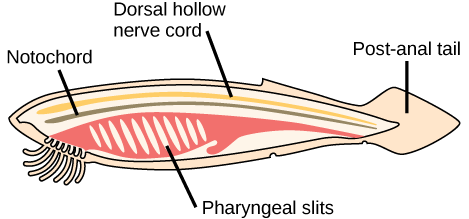
Which of the post-obit statements about mutual features of chordates is truthful?
- The dorsal hollow nerve cord is part of the chordate central nervous system.
- In vertebrate fishes, the pharyngeal slits get the gills.
- Humans are not chordates considering humans do not have a tail.
- Vertebrates practice not have a notochord at any point in their development; instead, they have a vertebral column.
- The endostyle secretes steroid hormones.
<!–<para>A–>
The dorsal hollow nerve cord is derived from ectoderm that rolls into a hollow tube during development. In chordates, it is located dorsally to the notochord. In contrast, the nervous arrangement in protostome animate being phyla is characterized by solid nervus cords that are located either ventrally and/or laterally to the gut. In vertebrates, the neural tube develops into the brain and spinal string, which together comprise the central nervous system (CNS). The peripheral nervous organization (PNS) refers to the peripheral fretfulness (including the cranial nerves) lying outside of the brain and spinal cord.
Pharyngeal slits are openings in the throat (the region only posterior to the mouth) that extend to the outside environment. In organisms that live in aquatic environments, pharyngeal slits allow for the get out of water that enters the mouth during feeding. Some invertebrate chordates use the pharyngeal slits to filter food out of the water that enters the mouth. The endostyle is a strip of ciliated fungus-producing tissue in the flooring of the throat. Food particles trapped in the mucus are moved along the endostyle toward the gut. The endostyle also produces substances similar to thyroid hormones and is homologous with the thyroid gland in vertebrates. In vertebrate fishes, the pharyngeal slits are modified into gill supports, and in jawed fishes, into jaw supports. In tetrapods (land vertebrates), the slits are highly modified into components of the ear, and tonsils and thymus glands. In other vertebrates, pharyngeal arches, derived from all three germ layers, give ascension to the oral jaw from the first pharyngeal arch, with the 2d arch becoming the hyoid and jaw support.
The post-anal tail is a posterior elongation of the body, extending across the anus. The tail contains skeletal elements and muscles, which provide a source of locomotion in aquatic species, such as fishes. In some terrestrial vertebrates, the tail besides helps with balance, courtship, and signaling when danger is well-nigh. In humans and other great apes, the post-anal tail is reduced to a vestigial coccyx ("tail bone") that aids in residual during sitting.
Link to Learning
Click for a video discussing the development of chordates and v characteristics that they share.
Chordates and the Evolution of Vertebrates
2 clades of chordates are invertebrates: Cephalochordata and Urochordata. Members of these groups likewise possess the v distinctive features of chordates at some point during their development.
Cephalochordata
Members of Cephalochordata possess a notochord, dorsal hollow tubular nerve cord, pharyngeal slits, endostyle/thyroid gland, and a post-anal tail in the adult stage ((Figure)). The notochord extends into the head, which gives the subphylum its name. Although the neural tube also extends into the head region, there is no well-defined encephalon, and the nervous system is centered around a hollow nerve string lying above the notochord. Extinct members of this subphylum include Pikaia, which is the oldest known cephalochordate. Excellently preserved Pikaia fossils were recovered from the Burgess shales of Canada and date to the middle of the Cambrian historic period, making them more than 500 million years old. Its beefcake of Pikaia closely resembles that of the extant lancelet in the genus Branchiostoma.
The lancelets are named for their bladelike shape. Lancelets are only a few centimeters long and are ordinarily institute buried in sand at the bottom of warm temperate and tropical seas. Cephalochordates are suspension feeders. A water current is created past cilia in the mouth, and is filtered through oral tentacles. H2o from the mouth and so enters the pharyngeal slits, which filter out food particles. The filtered water collects in a gill chamber called the atrium and exits through the atriopore. Trapped food particles are defenseless in a stream of mucus produced past the endostyle in a ventral ciliated fold (or groove) of the pharynx and carried to the gut. Nearly gas substitution occurs across the trunk surface. Sexes are separate and gametes are released into the water through the atriopore for external fertilization.
Cephalochordate anatomy. In the lancelet and other cephalochordates, the notochord extends into the head region. Adult lancelets retain all five key characteristics of chordates: a notochord, a dorsal hollow nerve cord, pharyngeal slits, an endostyle, and a post-anal tail.
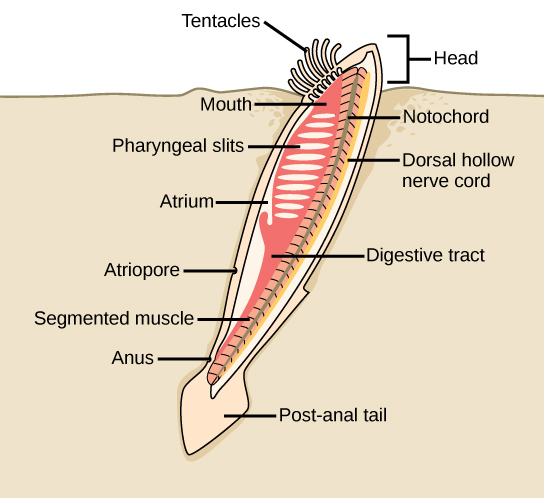
Urochordata
The 1,600 species of Urochordata are too known as tunicates ((Figure)). The name tunicate derives from the cellulose-like saccharide material, called the tunic, which covers the outer torso of tunicates. Although tunicates are classified as chordates, the adults do not take a notochord, a dorsal hollow nerve string, or a post-anal tail, although they do have pharyngeal slits and an endostyle. The "polliwog" larval class, nonetheless, possesses all v structures. Almost tunicates are hermaphrodites; their larvae hatch from eggs inside the developed tunicate's torso. After hatching, a tunicate larva (possessing all five chordate features) swims for a few days until it finds a suitable surface on which it can attach, ordinarily in a dark or shaded location. It then attaches via the caput to the surface and undergoes metamorphosis into the adult form, at which indicate the notochord, nerve cord, and tail disappear, leaving the pharyngeal gill slits and the endostyle as the ii remaining features of its chordate morphology.
Urochordate anatomy. (a) This photograph shows a colony of the tunicate Botrylloides violaceus. (b) The larval stage of the tunicate possesses all of the features characteristic of chordates: a notochord, a dorsal hollow nervus string, pharyngeal slits, an endostyle, and a post-anal tail. (c) In the adult phase, the notochord, nervus string, and tail disappear, leaving just the pharyngeal slits and endostyle. (credit: modification of piece of work by Dann Blackwood, USGS)

Developed tunicates may be either alone or colonial forms, and some species may reproduce by budding. Most tunicates alive a sessile existence on the ocean floor and are suspension feeders. However, chains of thaliacean tunicates called salps ((Figure)) tin swim actively while feeding, propelling themselves as they move h2o through the pharyngeal slits. The primary foods of tunicates are plankton and detritus. Seawater enters the tunicate's body through its incurrent siphon. Suspended material is filtered out of this h2o by a mucous cyberspace produced by the endostyle and is passed into the intestine via the action of cilia. The anus empties into the excurrent siphon, which expels wastes and water. Tunicates are found in shallow sea waters effectually the world.
Salps. These colonial tunicates feed on phytoplankton. Salps are sequential hermaphrodites, with younger female colonies fertilized by older male colonies. (credit: Oregon Department of Fish & Wildlife via Wikimedia Commons)
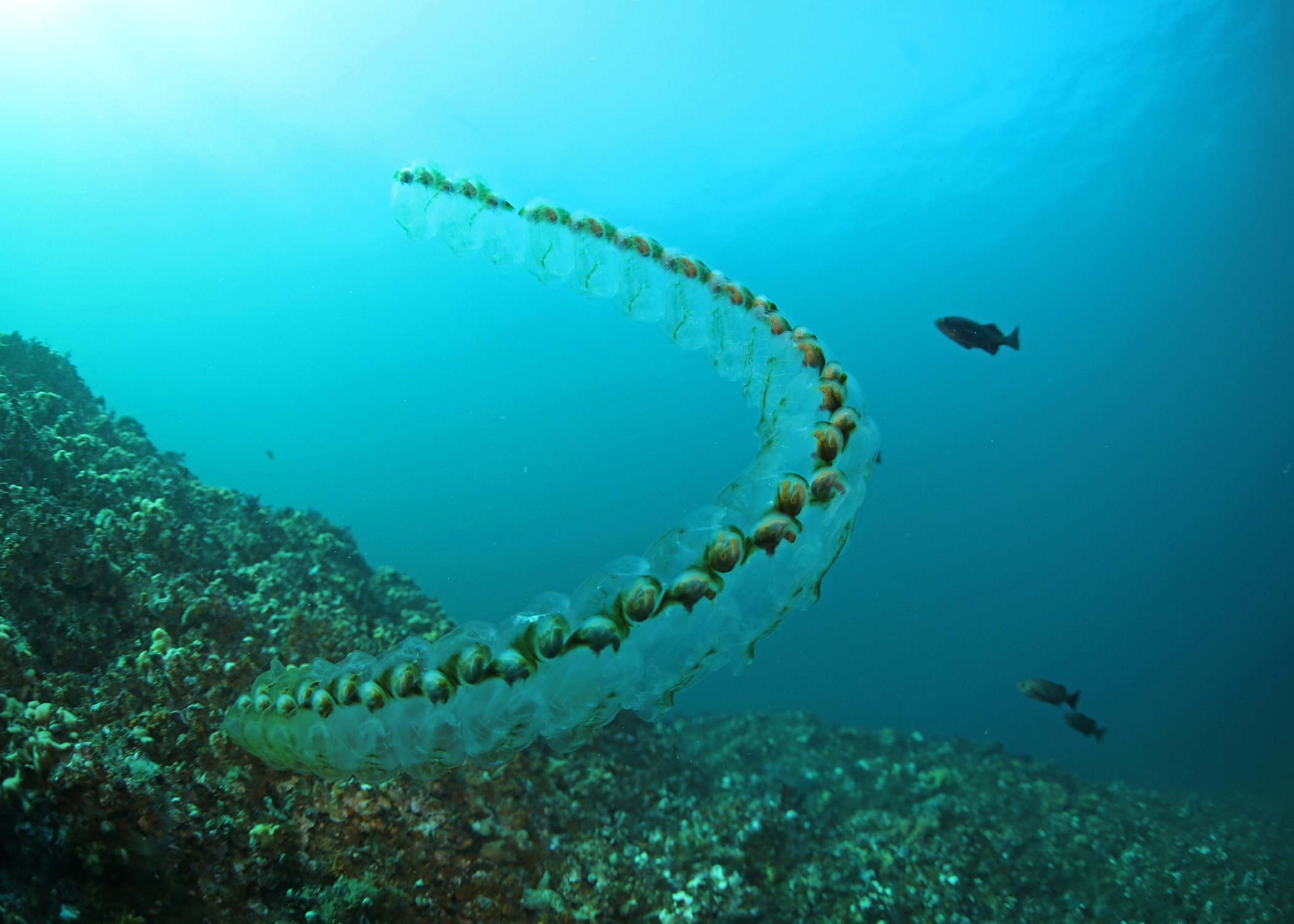
Subphylum Vertebrata (Craniata)
A cranium is a bony, cartilaginous, or gristly structure surrounding the brain, jaw, and facial basic ((Figure)). About bilaterally symmetrical animals have a head; of these, those that have a attic comprise the clade Craniata/Vertebrata, which includes the primitively jawless Myxini (hagfishes), Petromyzontida (lampreys), and all of the organisms chosen "vertebrates." (We should annotation that the Myxini have a attic just lack a backbone.)
A craniate skull. The subphylum Craniata (or Vertebrata), including this placoderm fish (Dunkleosteus sp.), are characterized by the presence of a attic, mandible, and other facial bones. (credit: "Steveoc 86"/Wikimedia Eatables)
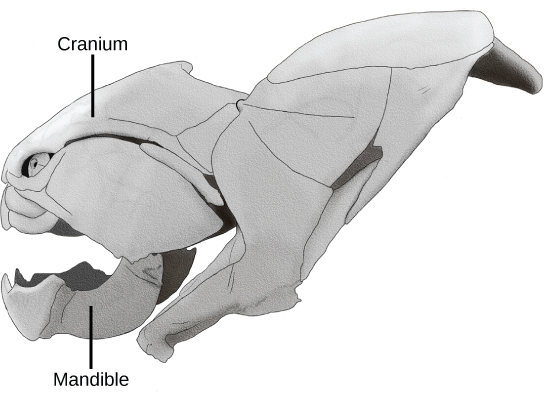
Members of the phylum Craniata/Vertebrata display the v characteristic features of the chordates; however, members of this group likewise share derived characteristics that distinguish them from invertebrate chordates. Vertebrates are named for the vertebral cavalcade, composed of vertebrae—a series of separate, irregularly shaped basic joined together to form a courage ((Figure)). Initially, the vertebrae course in segments around the embryonic notochord, but eventually supervene upon information technology in adults. In nearly derived vertebrates, the notochord becomes the nucleus pulposus of the intervertebral discs that cushion and back up adjacent vertebrae.
A vertebrate skeleton. Vertebrata are characterized by the presence of a backbone, such every bit the 1 that runs through the centre of this fish. All vertebrates are in the Craniata clade and have a cranium. (credit: Ernest V. More than; taken at Smithsonian Museum of Natural History, Washington, D.C.)
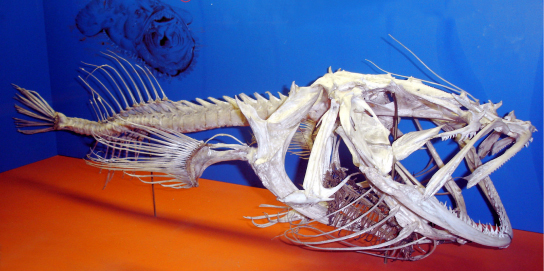
The relationship of the vertebrates to the invertebrate chordates has been a matter of contention, but although these cladistic relationships are even so being examined, it appears that the Craniata/Vertebrata are a monophyletic group that shares the five bones chordate characteristics with the other two subphyla, Urochordata and Cephalochordata. Traditional phylogenies place the cephalochordates equally a sister clade to the chordates, a view that has been supported past well-nigh current molecular analyses. This hypothesis is farther supported by the discovery of a fossil in China from the genus Haikouella. This organism seems to exist an intermediate class between cephalochordates and vertebrates. The Haikouella fossils are nigh 530 million years old and appear similar to modernistic lancelets. These organisms had a brain and eyes, every bit do vertebrates, only lack the skull found in craniates. 1 This evidence suggests that vertebrates arose during the Cambrian explosion.
Vertebrates are the largest group of chordates, with more than 62,000 living species, which are grouped based on anatomical and physiological traits. More than i classification and naming scheme is used for these animals. Here we will consider the traditional groups Agnatha, Chondrichthyes, Osteichthyes, Amphibia, Reptilia, Aves, and Mammalia, which constitute classes in the subphylum Vertebrata/Craniata. Virtually all modern cladists allocate birds inside Reptilia, which correctly reflects their evolutionary heritage. Thus, we now have the nonavian reptiles and the avian reptiles in our reptilian classification. We consider them separately only for convenience. Further, we volition consider hagfishes and lampreys together as jawless fishes, the Agnatha, although emerging classification schemes dissever them into chordate jawless fishes (the hagfishes) and vertebrate jawless fishes (the lampreys).
Animals that possess jaws are known as gnathostomes, which means "jawed mouth." Gnathostomes include fishes and tetrapods. Tetrapod literally means "four-footed," which refers to the phylogenetic history of various land vertebrates, even though in some of the tetrapods, the limbs may have been modified for purposes other than walking. Tetrapods include amphibians, reptiles, birds, and mammals, and technically could too refer to the extinct fishlike groups that gave rise to the tetrapods. Tetrapods can exist farther divided into two groups: amphibians and amniotes. Amniotes are animals whose eggs contain 4 extraembryonic membranes (yolk sac, amnion, chorion, and allantois) that provide diet and a water-retaining surround for their embryos. Amniotes are adapted for terrestrial living, and include mammals, reptiles, and birds.
Department Summary
The 5 feature features of chordates present during some time of their life cycles are a notochord, a dorsal hollow tubular nerve string, pharyngeal slits, endostyle/thyroid gland, and a post-anal tail. Chordata contains two clades of invertebrates: Urochordata (tunicates) and Cephalochordata (lancelets), together with the vertebrates in the Vertebrata/Craniata. Lancelets are intermission feeders that feed on phytoplankton and other microorganisms. Virtually tunicates live on the ocean floor and are suspension feeders. Which of the ii invertebrate chordate clades is more than closely related to the vertebrates continues to exist debated. Vertebrata is named for the vertebral column, which is a feature of almost all members of this clade. The name Craniata (organisms with a cranium) is considered to be synonymous with Vertebrata.
Visual Connection Questions
(Figure) Which of the following statements about common features of chordates is true?
- The dorsal hollow nerve cord is function of the chordate central nervous system.
- In vertebrate fishes, the pharyngeal slits become the gills.
- Humans are not chordates because humans do not take a tail.
- Vertebrates exercise not accept a notochord at any point in their development; instead, they have a vertebral column.
(Figure) A
Review Questions
Which of the following is non contained in phylum Chordata?
- Cephalochordata
- Echinodermata
- Urochordata
- Vertebrata
B
Which group of invertebrates is most closely related to vertebrates?
- cephalochordates
- echinoderms
- arthropods
- urochordates
A
Hagfish, lampreys, sharks, and tuna are all chordates that can also exist classified into which group?
- Craniates
- Vertebrates
- Cartilaginous fish
- Cephalocordata
A
Critical Thinking Questions
What are the characteristic features of the chordates?
The characteristic features of the phylum Chordata are a notochord, a dorsal hollow nerve string, pharyngeal slits, and a mail service-anal tail.
What is the structural advantage of the notochord in the homo embryo? Be sure to compare the notochord with the corresponding structure in adults.
The notochord is a flexible structure that provides support for the embryo's body and germination of the neural tube. In the adults, the notochord has been replaced by the bony, rigid vertebral column. This loss of flexibility restricts the motion of adult humans, and would make it unlikely that the embryo would fit within the pocket-sized space it is allotted inside the uterus.
Footnotes
- 1 Chen, J. Y., Huang, D. Y., and Li, C. West., "An early Cambrian craniate-like chordate," Nature 402 (1999): 518–522, doi:10.1038/990080.
Glossary
- Cephalochordata
- chordate clade whose members possess a notochord, dorsal hollow nerve cord, pharyngeal slits, and a post-anal tail in the adult stage
- Chordata
- phylum of animals distinguished past their possession of a notochord, a dorsal hollow nervus cord, pharyngeal slits, and a post-anal tail at some betoken during their development
- Craniata
- clade composed of chordates that possess a cranium; includes Vertebrata together with hagfishes
- cranium
- bony, cartilaginous, or fibrous construction surrounding the encephalon, jaw, and facial basic
- dorsal hollow nerve cord
- hollow, tubular structure derived from ectoderm, which is located dorsal to the notochord in chordates
- lancelet
- member of Cephalochordata; named for its bract-like shape
- notochord
- flexible, rod-shaped back up structure that is plant in the embryonic phase of all chordates and in the adult stage of some chordates
- pharyngeal slit
- opening in the throat
- post-anal tail
- muscular, posterior elongation of the body extending across the anus in chordates
- tetrapod
- phylogenetic reference to an organism with a four-footed evolutionary history; includes amphibians, reptiles, birds, and mammals
- tunicate
- sessile chordate that is a fellow member of Urochordata
- Urochordata
- clade composed of tunicates
- vertebral column
- series of divide bones joined together as a courage
- Vertebrata
- members of the phylum Chordata that possess a backbone
Source: https://opentextbc.ca/biology2eopenstax/chapter/chordates/